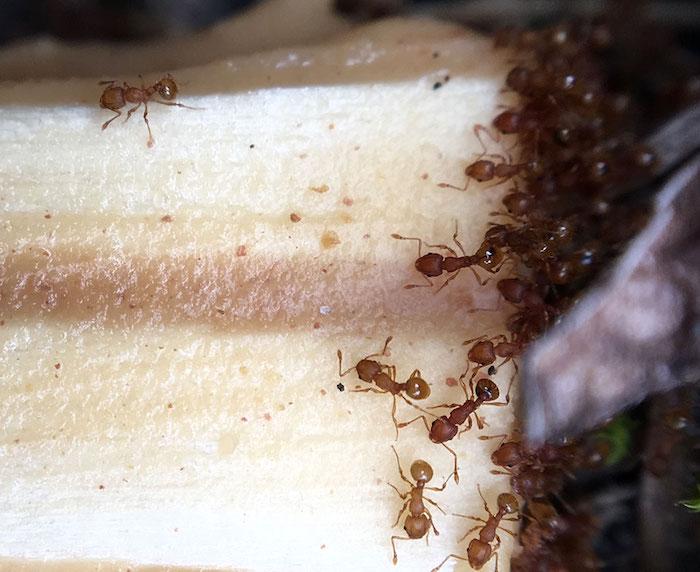
Little fire ants swarm the end of a chopstick laced with peanut butter during monitoring at the Steam Vents parking lot/NPS, Jessica Ferracane
A tiny invader has turned up in Hawai'i Volcanoes National Park, one that not only can be painful to visitors and park staff, but which can also have impacts on the park's ecosystem.
Little Fire Ants, which indeed are tiny, at roughly half the size of a sesame seed, can inflict painful bites that might linger for weeks. They also invite "plant pests such as aphids, white flies and scale insects, which secrete plant sap that the ants eat. In turn, the ants protect these insects from natural predators and parasites," the Hawai'i Invasive Species Council notes. "They may sting, and even blind, pets such as cats and dogs. In the Galapagos, they eat tortoise hatchlings and attack the eyes of adult tortoises."
The ants have been spotted in the national park in the popular Steam Vents area and Mauna Ulu parking lot on Kīlauea. These are the first known populations of LFA in the park, a park release said.
"Intensive sampling is underway to determine if the ants are more widespread. Park scientists are working with partners to respond quickly to the threat and evaluate control options while ensuring visitor safety and protecting native ecosystems. No bites have been reported, and no ant-related closures are in effect," added the release.
Little Fire Ants are an extremely noxious invasive species, which can have devastating impacts to native ecosystems and human health. Since 2014, Hawai‘i Volcanoes has sought to prevent the introduction of LFA by monitoring equipment, construction material, and the vehicles that transport them, before they enter the park. This year, officials have intercepted the small, biting ants a dozen times.
“We are concerned for the health and safety of our staff and visitors, and the fragile Hawaiian ecosystems of the park,” said David Benitez, park ecologist. “LFA really depend on humans to move them around. We need everyone to ensure their vehicles and gear are free of ants before coming into the park.”




 Support Essential Coverage of Essential Places
Support Essential Coverage of Essential Places







Comments
Are they just in the park or are they on the islands and just getting in the park?
Any idea how these ants were introduced?
According to the Hawai'i Invasive Species Council, these ants are widespread on the big island, in several places on Oahu and Maui, one place on Lauai, and not (yet) know on Molokai, Lanai, or Kahoolawe. https://dlnr.hawaii.gov/hisc/info/invasive-species-profiles/little-fire-...
They were likely introduced in nursery plants (possibly cut flowers), and they tend to spread across and between islands with plant material. They first were detected arond Puna & Hilo, but are established on the Kona side, too.
Lots more information available from various Hawaiian sources such as http://www.fireantfreemaui.org or http://www.littlefireants.com/